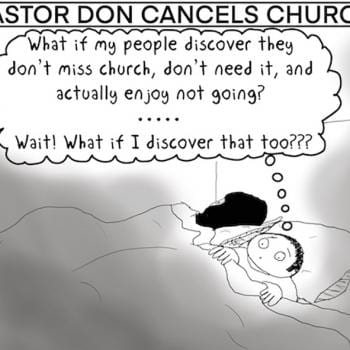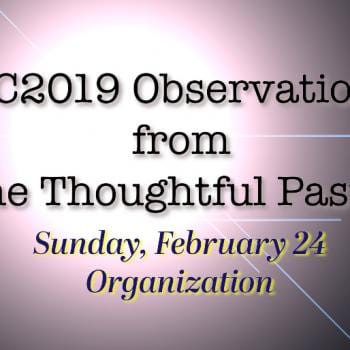It was a moment of amazing clarity as I suddenly saw why the United Methodist Church has such a dismal record creating successful church plants. I am defining “successful” as a plant that is showing extensive growth to the point of needing to plant satellite campuses within a few years, has a number of young adults and children participating in it, and is financially self-sustaining.
A little history here: Even before I retired from my full-time appointment, I had long been the religion columnist for the Denton Record-Chronicle, sister paper to the Dallas Morning News. I wrote a weekly column on anything that came to my mind that also had anything to do with religion.
After my retirement, a new managing editor, Scott Parks, came to Denton from the Dallas News and he was thrilled to know this smaller paper had a religion column. He and I soon met, and he offered this column idea for the next year: visit as many different churches as possible and describe my worship experience at each place. My model was to be Bill Martin (Dr. William Martin, Sociology prof at my alma mater, Rice University), who had done a well-received series of these columns for the Texas Monthly Magazine in the late 1990’s and early 2000’s.
Intrigued, I agreed to the project and have been doing this since the end of this past July. And in so doing, I do believe I have uncovered the reason why we in The United Methodist Church are essentially dismal failures at the church planting process. Despite the careful training offered and the support given to church planters by various Annual Conferences, with a few notable exceptions we are not doing well in this area.
There is definitely a formula that underlies a successful church plant and I’m beginning to suspect any deviation from that formula means inevitable failure. I think I’ve figured out that formula.
The Formula
- A young, male, good-looking, charismatic pastor, preferably with a beautiful “smokin’ hot” wife and a couple of photogenic children. Best if he is a former athlete, and has muscles bulging under his tight t-shirt.
- Superb branding and technology. One of my companions on these mystery worship visits owns a firm that creates brands and he observes signs of a pre-packaged and superbly produced branding every time we visit one of these successful church plants.
- Simple doctrinal statement: The Bible is inerrant; substitutionary atonement the only possible theory of atonement, everyone who does not ask Jesus into their hearts goes to hell, male leadership necessary particularly in lead pastor/preaching roles but often across the board in every key leadership position.
- No doctrinal disputes are permitted; there are especially no arguments over the inclusion of the GLBTQI community–they just all need to repent and become hetero or at least declare eternal celibacy.
- Sources of really big money undergird the movement. The latest, best and most visually stimulating technology is used along with paid professional musicians, worship leaders, and technology people.
- All worship bands have two slender and attractive women, preferably blonde and wearing tight jeans, singing and subtly (or not so subtly) dancing to the beat of the music.
- An extremely flexible and adaptive administrative structure which functions independently from any larger ecclesiastical oversight.
- An empire-building mindset: a desire to dominate the market, both local and international.
- Immersion baptism for adults only and very infrequent observance of the Lord’s Supper (and nothing even approaching a weekly Eucharist).
- An homogeneous target audience.
- Much use of simple proof-texting to support the message of the day. In-depth biblical scholarship that may reveal doubt or cast any suggestion that the Bible is not dictated by God is neither necessary nor desired.
In other words, keep it clean, neat, male-dominated, subtly sexual, simple and flexible, with professional branding AND no-funds-spared technological support.
This is total opposite of the world of The United Methodist Church and other historic, connectional-type churches.
- We have central administrative structures, hierarchical leadership and/or bloated bureaucracies with almost little or no flexibility to move quickly as t
he markets change.
- Our “brand” (open hearts, open doors, open minds) and our logo are anything but trendy and catchy, nor are they used consistently across the board.
- Our theology is anything but unified and uniform and is hotly debated in every possible forum.
- We operate out of strong social consciences which call for sacrificial action in order to offer inclusion to women, people of color, the physically differently-abled, and older clergy.
- We keep even dying churches alive out of respect to their long contribution to the world-wide church. Thus we do not have the financial means to pour into the plants and we do not have the empire building mentality that can discard those marginal churches as past their prime and a hindrance to the movement.
- We fight any kind of “ism” with passion, including the sexism that permeates these church plants.
- Our choices to live out of the Gospel mandates in these areas make it nearly impossible for us to be “successful” church planters.
I remember sitting at a clergy retreat a couple of years ago, looking around the room and thinking, “We are one beat-up looking group of people.” There are exceptions of course, but we tend to be older, plumper, more-female dominated, socially conscious people who so honor our connection that the idea of empire building rarely enters one of our theologically-trained brains. As a general rule (and yes, there are exceptions) we are not adequately young, handsome, male, sexually enticing or ambitious to be really successful at this venture.
So what do we do? How About “WalMart Needs Mom and Pop”?
The simple answer: If we really want to save the UMC as an institution, we need to let the Evangelicals take over. They have the simple doctrinal base (no gays, no divorced, inerrant Bible, etc) and tend to attract the good looking young male ambitious pastors that are absolutely necessary for success in this arena. They also apparently have some of the massive funding of the IRD (Institute for Religion and Democracy, a right-wing based political organization that appears to have been working hard to dismantle the UMC for quite a while now) behind them in order to make it work.
Those in the progressive wing–and I clearly am one–are not, for the most part, of the empire building mentality. Without that, and without the strong theologically-based fear that the vast majority of the world’s population is destined to burn in eternal torment if we don’t get the word out to them, we don’t have the base motivation for really successful church plants that bring large numbers of people and much money to the worship services. Also I suspect that many progressives are uncomfortable with the fact that sex sells, even in churches, and are less likely to buy into the subtle but undeniably present sexual undertones that seem to permeate the successful church plants.
But there may be another option.
What I think many progressives do well is make disciples. We ask people to seriously consider their own progress toward entire sanctification and their willingness to live out of the baptismal vow to stand firm against oppression in whatever form it takes.
We are willing to be more generous theologically and trust that God does want all to come into that place of gracious, holy and transformational love, having received the joy of forgiven reconciliation with God and thus willing to offer that to others.
Admittedly this doesn’t make big churches. It asks too much of people, requires them to think and to consider their own paths of righteousness and to take seriously the model that Jesus set that welcomes the unclean, the outsider, the marginalized, the unpretty and unnoticed and poor and beat up ones.
It’s important but it’s not popular. It works well with an organic church model, but not with the mega-church plant model. And without a series of highly successful mega-church plants and the high-dollar givers they attract, we are not going to make it as a denomination.
For some time now, I’ve been working on the idea that the large mega-church genuinely needs the smaller, disciple-making church. They can compliment each other as do the huge factory farms and the smaller organic gardens. Both have value. One can feed (evangelize) the masses; the other can concentrate on deep health and longevity.
To use another analogy: I’m suggesting that WalMart NEEDS the Mom and Pop stores–and it goes both ways. Yes, the big box stores often have lower prices and far greater inventory, but there is a significant subset of people who very much prefer to shop at locally owned places where they are known. They find the higher prices worth the personal connection and sense of “everyone knows your name” enjoyment.
But we have to work together, to honor one another, to see and acknowledge the need for one another in order to make a cohesive whole. Obviously that mutual respect and honor rarely happen, in agriculture. commerce or in the world of church and theology.
But what if we could re-create the UMC as a place that honors both the aggressive evangelistic push and simpler theology of the more conservative branch AND the more theologically open, disciple-making progressive branch?
What if we could recognize that we need both to thrive, not just one side. That a healthy church ecology mimics a healthy physical ecology and that monoculture is ultimately destructive even though for the short-term it seems more productive?
Could we then sing together, “Blessed be the Ties that Bind?”
Blest be the tie that binds
Our hearts in Christian love;
The fellowship of kindred minds
Is like to that above.
Would that we could mimic the unity of the Trinity in our own.

















